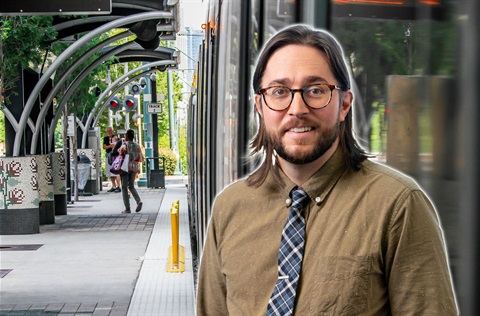Art on the Move: Celebrating World Art Day Through Transit
Published on April 15, 2024

by Brandon T Hunter
The CATS Art in Transit Program stands out as a one of our many commitments to cultural enrichment and community engagement. Led by Chris Lange, the program's administrator, the program combines practical transit needs with artistic expression, transforming commutes into artistic experiences. Lange, who has been in his role for nearly a decade, explains his role as multifaceted and community-oriented. His background in arts management and photography enriches his capacity to blend aesthetic vision with transit planning.
"My role is to work with other project teams to integrate art into our system, whether that be at a light rail stop or a park and ride," he shares.
The primary goal of Art in Transit is to encourage ridership by creating welcoming spaces for our riders and the public as well, according to Lange. This initiative not only enhances the visual appeal of transit spaces but also fosters a deeper connection with the community. By reflecting local culture and history through art, it cultivates a sense of ownership in the community.
Started in 2002 by the Metropolitan Transit Commission, the program has grown significantly, keeping the community's heart and soul in each project. Artists, both local and national, are chosen through a meticulous selection process overseen by local art professionals. This not only supports the local artistic community but also brings diverse perspectives into city spaces.
Diversity and inclusivity are pillars of the program's selection criteria. "It's ingrained in our criteria to think about and implement diversity in the selection of all of our artists," Lange points out, highlighting the program's commitment to representing all community voices.
A memorable impact of the program was during the challenging times at the height of the COVID-19 pandemic. The "Ride with the Music" initiative brought live performances back to open-air public spaces, providing much-needed relief and joy to riders. Lange recalls a moment at the JW Clay Blue Line station, where a commuter was visibly moved by a performance, a testament to the profound emotional resonance of accessible art.
Collaborations have been key to the program's success, with partnerships with local organizations like Jazz Arts and ArtPop proving particularly fruitful. These collaborations not only enhance the program's reach but also integrate art more deeply into the community's daily life.
For Lange, the most rewarding aspect of his job is working with artists and witnessing their excitement as their creations become part of the transit system. He encourages communities and artists to engage with Art in Transit, whether by joining the artist roster, applying for art opportunities, scheduling an art tour, or utilizing the Art in Transit mobile app.
As we celebrate World Art Day, the Art in Transit Program serves as a powerful reminder of the role of art in public spaces. It's a testament to how art and urban planning can come together to beautify a space and enhance the public's daily experiences. This program not only adorns our city but also reconnects its people to the cultural heartbeat.
Back to CATS Chronicles